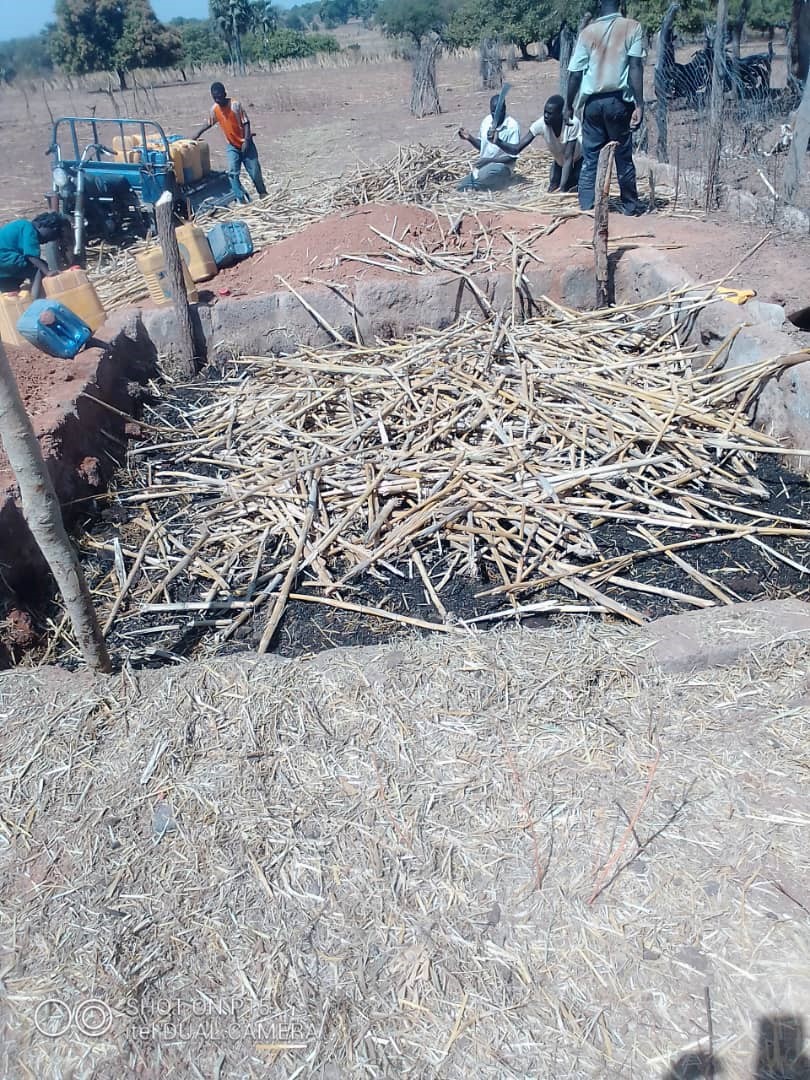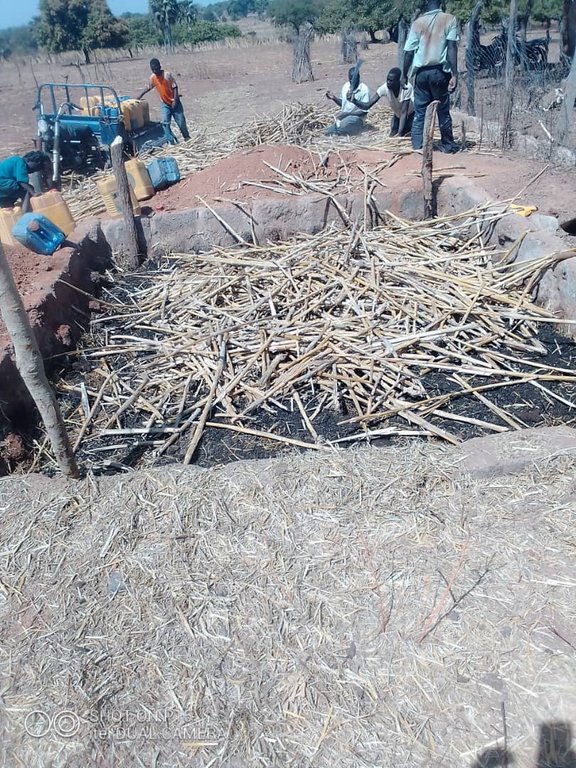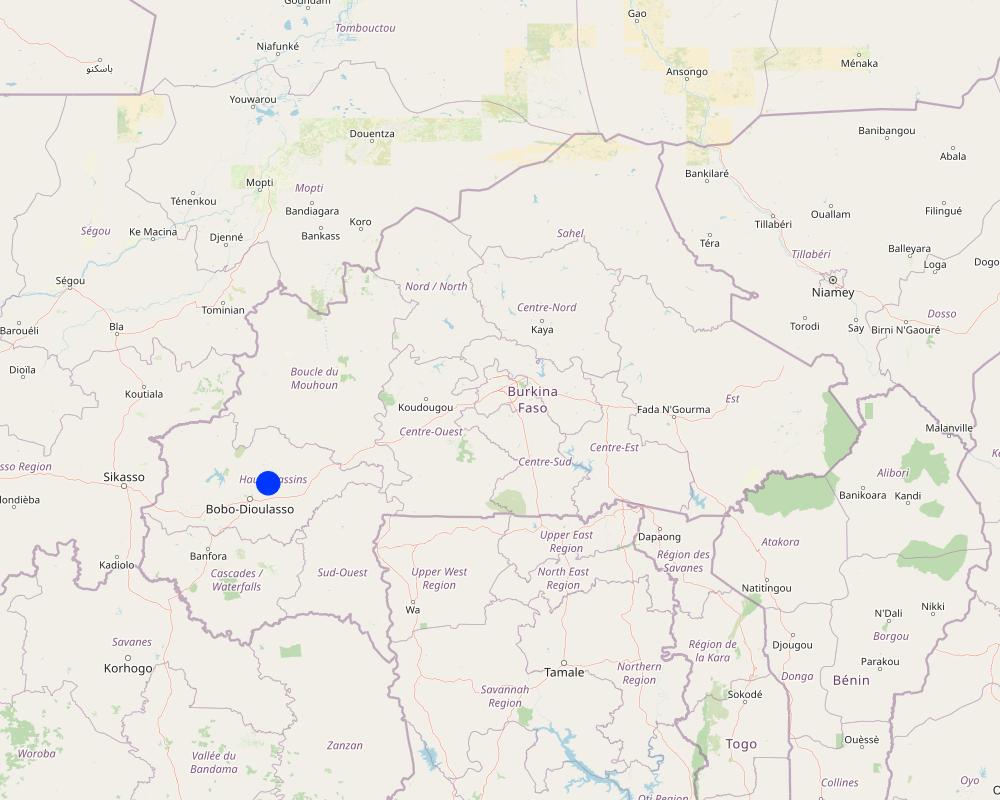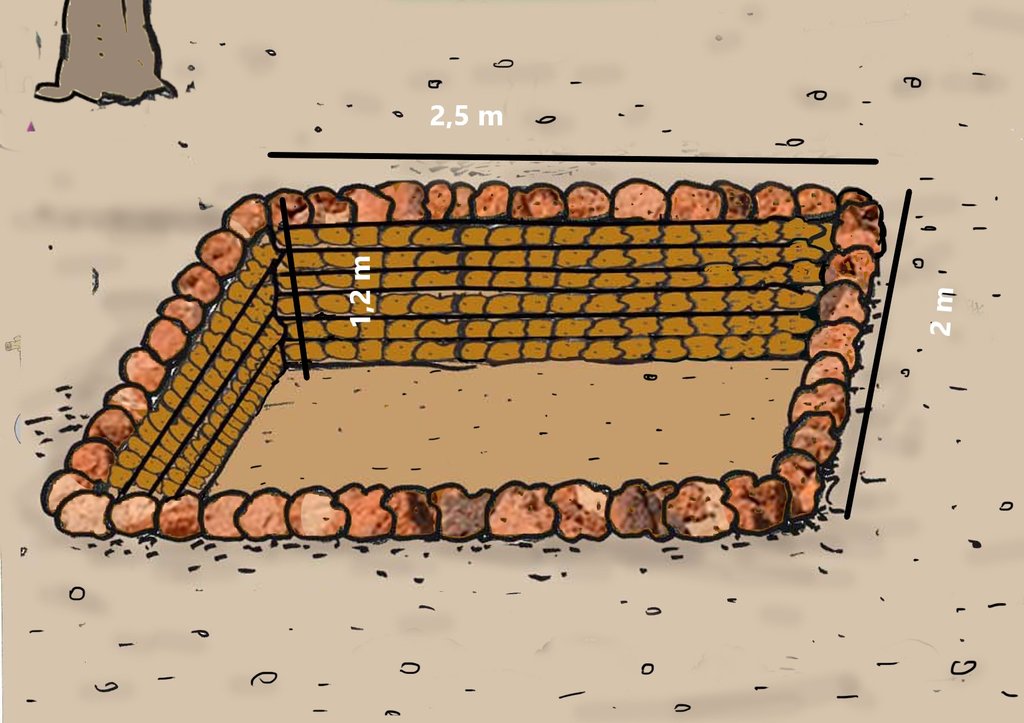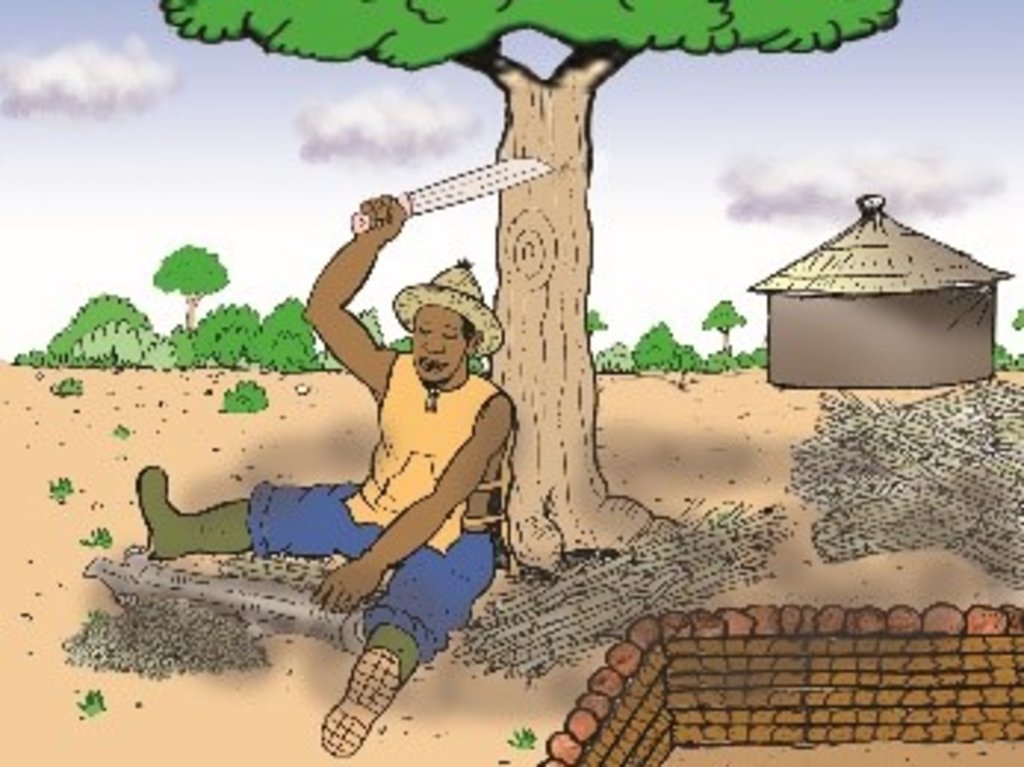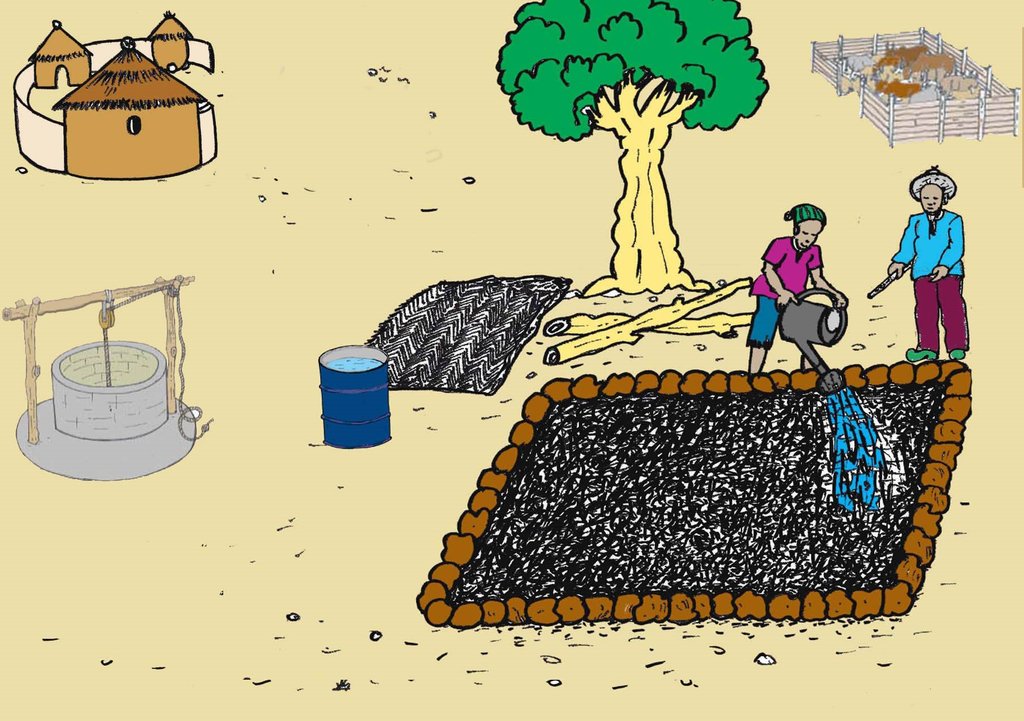Pit Composting [Burkina Faso]
- Creation:
- Update:
- Compiler: Moussa ABOU
- Editors: Siagbé Golli, Brice Sosthène BAYALA, Tabitha Nekesa, Ahmadou Gaye
- Reviewers: Sally Bunning, Rima Mekdaschi Studer, William Critchley
Nogo dinguè
technologies_6677 - Burkina Faso
View sections
Expand all Collapse all1. General information
1.2 Contact details of resource persons and institutions involved in the assessment and documentation of the Technology
Key resource person(s)
land user:
SANOU Zakaria
Burkina Faso
Name of project which facilitated the documentation/ evaluation of the Technology (if relevant)
Soil protection and rehabilitation for food security (ProSo(i)l)Name of the institution(s) which facilitated the documentation/ evaluation of the Technology (if relevant)
Deutsche Gesellschaft für Internationale Zusammenarbeit (GIZ)1.3 Conditions regarding the use of data documented through WOCAT
The compiler and key resource person(s) accept the conditions regarding the use of data documented through WOCAT:
Yes
1.4 Declaration on sustainability of the described Technology
Is the Technology described here problematic with regard to land degradation, so that it cannot be declared a sustainable land management technology?
No
2. Description of the SLM Technology
2.1 Short description of the Technology
Definition of the Technology:
Pit composting is a technology that involves gathering residues in a pit and facilitating their decomposition through the activity of microorganisms. The residues utilized in this process can include plant debris, animal waste, food scraps, and suitable urban and industrial waste.
2.2 Detailed description of the Technology
Description:
Pit composting is a technique involving the construction of a pit where various residues are gathered and regularly watered until complete aerobic decomposition occurs. This technology is applicable in both dry and wet areas, but it is essential to place the pit in a shaded, easily accessible location close to a water source.
The pit's dimensions vary based on available manpower, material resources, and the producer's specific needs. For the purpose of this documentation, a pit with dimensions of 1.2 meters in depth, 2 meters in width, and 2.5 meters in length is suggested, resulting in a production capacity of 6 cubic meters of compost. Pit composting can be carried out in any season but is preferably done during the dry season after the harvest, starting around September-October.
The objectives of pit composting include reversing soil degradation, optimizing the recycling of soil nutrients through crop residues, and mitigating the impact of mineral fertilizers on the soil by increasing organic matter content. The implementation of this technology enhances the soil's water retention capacity, improves its structure, and boosts crop resistance to certain diseases and the parasitic plant Striga.
The primary activities involved in pit composting include:
•Digging the pit
•Preparing residues
•Layering and watering
•Closing the pit
•Turning and watering
The major inputs required for this technology are:
•Crop residues (stover: i.e. stems and leaves), threshing residues (husks), and plant debris
•Commonly used fermenting agents such as animal dung (cattle dung, poultry droppings, manure, household yard soil)
•Ash
•Water
•Tools (pickaxe, shovel, cement, wheelbarrow, fork, cart)
Pit composting positively impacts the physical, chemical, and biological properties of the soil. Compost enables rapid soil recovery after production and enhances its resilience to the effects of climate change.
Producers assert that this technology improves yields, reduces input costs, and consequently contributes to enhancing their income.
2.3 Photos of the Technology
2.5 Country/ region/ locations where the Technology has been applied and which are covered by this assessment
Country:
Burkina Faso
Region/ State/ Province:
Hauts-Bassins region
Further specification of location:
Sala (Satiri commune)
Specify the spread of the Technology:
- applied at specific points/ concentrated on a small area
Is/are the technology site(s) located in a permanently protected area?
No
Map
×2.6 Date of implementation
Indicate year of implementation:
2019
2.7 Introduction of the Technology
Specify how the Technology was introduced:
- through projects/ external interventions
Comments (type of project, etc.):
The technology was introduced by the National Land Management Program (PNGT).
3. Classification of the SLM Technology
3.1 Main purpose(s) of the Technology
- improve production
- reduce, prevent, restore land degradation
- adapt to climate change/ extremes and its impacts
- mitigate climate change and its impacts
- create beneficial economic impact
3.2 Current land use type(s) where the Technology is applied
Land use mixed within the same land unit:
No

Cropland
- Annual cropping
Annual cropping - Specify crops:
- cereals - maize
- cereals - millet
Number of growing seasons per year:
- 1
Is intercropping practiced?
Yes
If yes, specify which crops are intercropped:
Cowpea, Voandzou (Bambara groundnut)
Is crop rotation practiced?
Yes
If yes, specify:
Maize - Millet
3.3 Has land use changed due to the implementation of the Technology?
Has land use changed due to the implementation of the Technology?
- No (Continue with question 3.4)
3.4 Water supply
Water supply for the land on which the Technology is applied:
- rainfed
3.5 SLM group to which the Technology belongs
- integrated soil fertility management
- waste management/ waste water management
3.6 SLM measures comprising the Technology

agronomic measures
- A2: Organic matter/ soil fertility
- A3: Soil surface treatment
- A6: Residue management
A3: Differentiate tillage systems:
A 3.3: Full tillage (< 30% soil cover)
A6: Specify residue management:
A 6.3: collected
3.7 Main types of land degradation addressed by the Technology

soil erosion by water
- Wt: loss of topsoil/ surface erosion

chemical soil deterioration
- Cn: fertility decline and reduced organic matter content (not caused by erosion)

biological degradation
- Bq: quantity/ biomass decline
3.8 Prevention, reduction, or restoration of land degradation
Specify the goal of the Technology with regard to land degradation:
- reduce land degradation
- restore/ rehabilitate severely degraded land
4. Technical specifications, implementation activities, inputs, and costs
4.1 Technical drawing of the Technology
Technical specifications (related to technical drawing):
Pit length: 2.5 m ;
Pit width: 2 m ;
Pit depth : 1.2 m ;
Pit volume: 6 cubic meter of compost.
Author:
ProSoil/GIZ
Date:
2021
Technical specifications (related to technical drawing):
Cutting crop residues into small pieces
Author:
ProSoil/GIZ
Date:
2021
Technical specifications (related to technical drawing):
Backfilling the pit
Author:
ProSoil/GIZ
Date:
2021
Technical specifications (related to technical drawing):
Watering and checking the decomposition process of the pit materials
Author:
ProSoil/GIZ
Date:
2021
4.2 General information regarding the calculation of inputs and costs
Specify how costs and inputs were calculated:
- per Technology unit
Specify unit:
Pit
Specify dimensions of unit (if relevant):
6 cubic meter
If relevant, indicate exchange rate from USD to local currency (e.g. 1 USD = 79.9 Brazilian Real): 1 USD =:
613.5
Indicate average wage cost of hired labour per day:
CFA F 3,000
4.3 Establishment activities
| Activity | Timing (season) | |
|---|---|---|
| 1. | Preparing the pit | Dry season |
| 2. | Filling the pit | Dry season |
| 3. | Watering | Dry season |
| 4. | Turning over the heap | Dry season |
| 5. | Spreading | May-June |
Comments:
The heap is turned over every two (02) weeks.
4.4 Costs and inputs needed for establishment
| Specify input | Unit | Quantity | Costs per Unit | Total costs per input | % of costs borne by land users | |
|---|---|---|---|---|---|---|
| Labour | Labor | Pit | 1.0 | 35000.0 | 35000.0 | 100.0 |
| Equipment | Pickaxe | Number | 1.0 | 3500.0 | 3500.0 | 100.0 |
| Equipment | Shovel | Number | 1.0 | 2000.0 | 2000.0 | 100.0 |
| Equipment | Rake | Number | 1.0 | 5000.0 | 5000.0 | 100.0 |
| Equipment | Wheelbarrow | Number | 1.0 | 35000.0 | 35000.0 | 100.0 |
| Equipment | Fork | Number | 1.0 | 3000.0 | 3000.0 | 100.0 |
| Equipment | Watering can | Number | 1.0 | 2000.0 | 2000.0 | 100.0 |
| Construction material | Cement | Bag | 3.0 | 6500.0 | 19500.0 | 100.0 |
| Construction material | Brick | Number | 90.0 | 525.0 | 47250.0 | 100.0 |
| Other | Water | Drum | 15.0 | 1000.0 | 15000.0 | 100.0 |
| Total costs for establishment of the Technology | 167250.0 | |||||
| Total costs for establishment of the Technology in USD | 272.62 | |||||
Comments:
In our case, the pit was lined with bricks and cement to make it more stable, albeit at a significant cost. Opting for a more cost-effective approach would involve forgoing the cemented brick lining, resulting in a significant reduction in investment costs. However, this alternative would necessitate a bit more manpower for annual pit refurbishment.
4.5 Maintenance/ recurrent activities
| Activity | Timing/ frequency | |
|---|---|---|
| 1. | Watering | Dry season |
| 2. | Turning over the heap | Dry season |
| 3. | Spreading | May-June |
4.6 Costs and inputs needed for maintenance/ recurrent activities (per year)
| Specify input | Unit | Quantity | Costs per Unit | Total costs per input | % of costs borne by land users | |
|---|---|---|---|---|---|---|
| Labour | Watering | Pit | 1.0 | 12000.0 | 12000.0 | 100.0 |
| Labour | Turning over the heap | Number | 4.0 | 3000.0 | 12000.0 | 100.0 |
| Labour | Spreading | Day | 1.0 | 3000.0 | 3000.0 | 100.0 |
| Total costs for maintenance of the Technology | 27000.0 | |||||
| Total costs for maintenance of the Technology in USD | 44.01 | |||||
4.7 Most important factors affecting the costs
Describe the most determinate factors affecting the costs:
Equipment price fluctuations are the most significant factors affecting costs.
5. Natural and human environment
5.1 Climate
Annual rainfall
- < 250 mm
- 251-500 mm
- 501-750 mm
- 751-1,000 mm
- 1,001-1,500 mm
- 1,501-2,000 mm
- 2,001-3,000 mm
- 3,001-4,000 mm
- > 4,000 mm
Specify average annual rainfall (if known), in mm:
900.00
Specifications/ comments on rainfall:
The Hauts Bassins region, where the village of Sala (Saitiri commune) is located, experiences a North Sudanese and South Sudanese tropical climate. This climate is characterized by two (02) main seasons: a wet season lasting 06 to 07 months (May to October/November) and a dry season lasting 05 to 06 months (November/December to April). Annual rainfall is relatively abundant, ranging from 800 to 1,200 mm.
Indicate the name of the reference meteorological station considered:
Satiri Rainfall Station
Agro-climatic zone
- sub-humid
Average temperatures fluctuate between 24°c and 30°c, with a relatively small temperature range of 5°c.
5.2 Topography
Slopes on average:
- flat (0-2%)
- gentle (3-5%)
- moderate (6-10%)
- rolling (11-15%)
- hilly (16-30%)
- steep (31-60%)
- very steep (>60%)
Landforms:
- plateau/plains
- ridges
- mountain slopes
- hill slopes
- footslopes
- valley floors
Altitudinal zone:
- 0-100 m a.s.l.
- 101-500 m a.s.l.
- 501-1,000 m a.s.l.
- 1,001-1,500 m a.s.l.
- 1,501-2,000 m a.s.l.
- 2,001-2,500 m a.s.l.
- 2,501-3,000 m a.s.l.
- 3,001-4,000 m a.s.l.
- > 4,000 m a.s.l.
Indicate if the Technology is specifically applied in:
- not relevant
Comments and further specifications on topography:
The site evaluated is situated at 359 masl.
5.3 Soils
Soil depth on average:
- very shallow (0-20 cm)
- shallow (21-50 cm)
- moderately deep (51-80 cm)
- deep (81-120 cm)
- very deep (> 120 cm)
Soil texture (topsoil):
- fine/ heavy (clay)
Soil texture (> 20 cm below surface):
- medium (loamy, silty)
Topsoil organic matter:
- medium (1-3%)
If available, attach full soil description or specify the available information, e.g. soil type, soil PH/ acidity, Cation Exchange Capacity, nitrogen, salinity etc.
The soils in the area are predominantly tropical ferruginous soils with minimal or no leaching, and mostly deep hydromorphic (waterlogged) soils (over 100 cm deep). The sandy-clay nature of these soils makes them sensitive to water erosion.
5.4 Water availability and quality
Ground water table:
5-50 m
Availability of surface water:
medium
Water quality (untreated):
poor drinking water (treatment required)
Water quality refers to:
both ground and surface water
Is water salinity a problem?
No
Is flooding of the area occurring?
No
5.5 Biodiversity
Species diversity:
- medium
Habitat diversity:
- medium
5.6 Characteristics of land users applying the Technology
Sedentary or nomadic:
- Sedentary
Market orientation of production system:
- mixed (subsistence/ commercial)
Off-farm income:
- less than 10% of all income
Relative level of wealth:
- average
Individuals or groups:
- individual/ household
Level of mechanization:
- animal traction
Gender:
- men
Age of land users:
- middle-aged
5.7 Average area of land used by land users applying the Technology
- < 0.5 ha
- 0.5-1 ha
- 1-2 ha
- 2-5 ha
- 5-15 ha
- 15-50 ha
- 50-100 ha
- 100-500 ha
- 500-1,000 ha
- 1,000-10,000 ha
- > 10,000 ha
Is this considered small-, medium- or large-scale (referring to local context)?
- medium-scale
5.8 Land ownership, land use rights, and water use rights
Land ownership:
- individual, not titled
Land use rights:
- individual
Water use rights:
- communal (organized)
Are land use rights based on a traditional legal system?
Yes
Specify:
Land use rights are acquired through inheritance, gift and lending.
Comments:
Based on information gathered from both literature and interviews, there are two (02) main types of land tenure rights in the Hauts-Bassins region: permanent and temporary. Permanent tenure rights are acquired through inheritance or gift. Temporary tenure rights are generally acquired through land borrowing. However, it should be noted that landowners are currently selling their lands.
5.9 Access to services and infrastructure
health:
- poor
- moderate
- good
education:
- poor
- moderate
- good
technical assistance:
- poor
- moderate
- good
employment (e.g. off-farm):
- poor
- moderate
- good
markets:
- poor
- moderate
- good
energy:
- poor
- moderate
- good
roads and transport:
- poor
- moderate
- good
drinking water and sanitation:
- poor
- moderate
- good
financial services:
- poor
- moderate
- good
Comments:
The village of Sala is accessed via the RN 10 asphalt road. The village boasts health, education and drinking water infrastructures, as well as a market that attracts people from neighboring villages and from Bobo-Dioulasso (Burkina Faso's economic capital). The village's proximity to Bobo-Dioulasso means that it has access to basic socio-economic services and infrastructures.
6. Impacts and concluding statements
6.1 On-site impacts the Technology has shown
Socio-economic impacts
Production
crop production
Quantity before SLM:
2 tons
Quantity after SLM:
3 tons
Comments/ specify:
Farmers report an increase in production, highlighting, for instance, an elevation in maize yield from two to three tons and an increase in millet production from one to one and a half tons. This performance was achieved over a three-year period, attributed to the adoption of organic fertilizer along with improved seeds, Striga sp. control, and adherence to production schedules.
crop quality
Income and costs
expenses on agricultural inputs
farm income
Socio-cultural impacts
food security/ self-sufficiency
recreational opportunities
Comments/ specify:
The option of brick-and-cement stabilized pits means that no pits need to be built every year, which opens up opportunities for farmers to engage in leisure activities. In addition, these opportunities are provided by the income generated through increased farm income.
SLM/ land degradation knowledge
Ecological impacts
Soil
soil moisture
soil organic matter/ below ground C
Biodiversity: vegetation, animals
Vegetation cover
6.2 Off-site impacts the Technology has shown
Specify assessment of off-site impacts (measurements):
No impact off-site
6.3 Exposure and sensitivity of the Technology to gradual climate change and climate-related extremes/ disasters (as perceived by land users)
Other climate-related consequences
Other climate-related consequences
| How does the Technology cope with it? | |
|---|---|
| reduced growing period | well |
6.4 Cost-benefit analysis
How do the benefits compare with the establishment costs (from land users’ perspective)?
Short-term returns:
positive
Long-term returns:
positive
How do the benefits compare with the maintenance/ recurrent costs (from land users' perspective)?
Short-term returns:
positive
Long-term returns:
positive
Comments:
The technology leads to a reduction in expenditures on agricultural inputs, subsequently lowering overall farm-related costs. This, in turn, contributes to an improvement in producers' incomes. Additionally, farmers are not required to construct pits annually, further streamlining the process.
6.5 Adoption of the Technology
- > 50%
Of all those who have adopted the Technology, how many did so spontaneously, i.e. without receiving any material incentives/ payments?
- 51-90%
Comments:
Farmers say they have adopted this technology not only because it contributes to reducing farm input costs, but also because it improves yields. These factors help improve farmers' incomes.
6.6 Adaptation
Has the Technology been modified recently to adapt to changing conditions?
No
6.7 Strengths/ advantages/ opportunities of the Technology
| Strengths/ advantages/ opportunities in the land user’s view |
|---|
| Farmers believe that this technology not only helps increase yields, but also improves food security and reduces input costs. |
| Strengths/ advantages/ opportunities in the compiler’s or other key resource person’s view |
|---|
| Increased yields combined with reduced expenditure on agricultural inputs help improve farmers' incomes. This explains why farmers are so keen to adopt the technology. |
6.8 Weaknesses/ disadvantages/ risks of the Technology and ways of overcoming them
| Weaknesses/ disadvantages/ risks in the land user’s view | How can they be overcome? |
|---|---|
| Access to materials and equipment for pit construction. | Subsidize materials and equipment. |
| Weaknesses/ disadvantages/ risks in the compiler’s or other key resource person’s view | How can they be overcome? |
|---|---|
| The availability of water for watering and transporting organic fertilizer are weaknesses in the implementation of this technology. | Create watering points and pits near the farms to be improved. |
7. References and links
7.1 Methods/ sources of information
- field visits, field surveys
10
- interviews with land users
10
- interviews with SLM specialists/ experts
1
- compilation from reports and other existing documentation
6
When were the data compiled (in the field)?
01/19/2023
7.2 References to available publications
Title, author, year, ISBN:
Recueil des pratiques agro-écologiques éprouvées et mises en œuvre au Burkina Faso, Centre National de la Recherche Scientifique et Technologique, 2020/Compendium of proven agro-ecological practices implemented in Burkina Faso, National Scientific and Technological Research Center, 2020
Available from where? Costs?
Available on the Internet
Title, author, year, ISBN:
Catalogue de bonnes pratiques d’adaptation aux risques climatiques au Burkina Faso, UICN/ Ministère de l’Environnement et du Développement Durable, 2011/A catalog of good climate risk adaptation practices in Burkina Faso, IUCN/Ministry of the Environment and Sustainable Development, 2011
Available from where? Costs?
Available on the Internet
Title, author, year, ISBN:
Catalogue de fiches techniques des mesures d’amélioration de la fertilité des sols, Projet « Réhabilitation et protection des sols dégradés et renforcement des instances foncières locales dans les zones rurales du Burkina Faso » (ProSol), 2020
Available from where? Costs?
Available at ProSol-Burkina Faso
Title, author, year, ISBN:
Réalisation d’un diagnostic de l’état des ressources naturelles et de la gestion foncière dans les régions du Sud-Ouest et des Hauts-Bassins au Burkina Faso, Projet « Réhabilitation et protection des sols dégradés et renforcement des instances foncières locales dans les zones rurales du Burkina Faso » (ProSol), 2015/A diagnostic study of the state of natural resources and land tenure management in the South-West and Hauts-Bassins regions of Burkina Faso, under the project entitled "Rehabilitation and protection of degraded soils and strengthening of local land tenure bodies in the rural areas of Burkina Faso" (ProSol), 2015
Available from where? Costs?
Available at ProSol-Burkina Faso
Title, author, year, ISBN:
Gender-sensitive Sustainable Land Management (SLM) module, ProSol, 2021.
Available from where? Costs?
Available at ProSol-Burkina Faso
Title, author, year, ISBN:
Diagnostic sur les sites d’extension de quatre (04) micros bassins versants au profit du ProSol, Projet « Réhabilitation et protection des sols dégradés et renforcement des instances foncières locales dans les zones rurales du Burkina Faso » (ProSol), 2020/A diagnostic assessment of the extension sites of four (04) micro-catchment areas for the ProSol project, "Rehabilitation and protection of degraded soils and strengthening of local land tenure bodies in the rural areas of Burkina Faso" (ProSol), 2020
Available from where? Costs?
Available at ProSol-Burkina Faso
Links and modules
Expand all Collapse allLinks
No links
Modules
No modules


